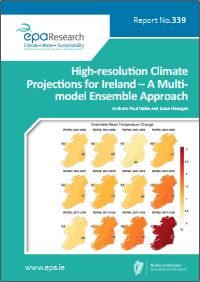Research 339: High-resolution Climate Projections for Ireland – A Multi-model Ensemble Approach
Authors: Paul Nolan and Jason Flanagan
Summary: In this study, regional climate models were employed to dynamically downscale the coarse information of Global Climate Models to provide detailed projections of 21st-century regional climate change in Ireland. The projections were run at high spatial resolution (4 km grid spacing), allowing a more accurate evaluation of the local impacts of climate change.

High-resolution Climate Projections for Ireland – A Multi-model Ensemble Approach PART 2
High-resolution Climate Projections for Ireland – A Multi-model Ensemble Approach PART 3
Project Highlights
Watch the project highlights video
Regional climate models (RCMs) take the outputs from global climate models (GCMs) to produce more refined projections of the potential local and regional impacts of climate change. The current study used RCMs to simulate the mid-21st-century climate of Ireland. The projections were run at high spatial resolution (4 km), allowing a more realistic representation of important physical processes and enabling a more accurate evaluation of the local impacts. To address the uncertainty inherent in climate model projections, different RCMs were used to downscale outputs from a number of different CMIP5 (Coupled Model Intercomparison Project – Phase 5) GCMs. A statistical analysis of the resulting multi-model ensemble of downscaled datasets was completed allowing for the uncertainty in the projections to be partially quantified. To address the uncertainty in future emissions and changing land use, and how the world will come together to response to the challenge of climate change, the future climate was simulated under both Representative Concentration Pathway 4.5 (RCP4.5) and RCP8.5 scenarios. The climate projections of the current report are in broad agreement with previous research, which adds a measure of confidence to the projections.
Identifying Pressures
Ireland’s climate is changing, resulting in higher temperatures, changing precipitation patterns and increases in the frequency and intensity of extreme events, with these changes expected to continue and intensify into the future. Ongoing and projected climate change impacts pose significant risks to all aspects of Ireland’s economy, society and environment. Accurate climate projections, produced by high-resolution RCMs, can assist national policymakers to plan for, and adapt to, the adverse effects of climate change.
Informing Policy
This research will inform national climate policy and further the understanding of the potential impacts of climate change in Ireland. Furthermore, the research will inform the climate change adaptation action that various governmental departments and local authorities are mandated to undertake under the National Adaptation Framework. Selected findings from this study indicate that by the middle of this century (2041–2060):
- temperatures are projected to increase by 1–1.6°C compared with the baseline period (1981–2000), with the largest increases in the east;
- warming will be enhanced at the extremes (i.e. hot days and cold nights), with summer daytime and winter nighttime temperatures projected to increase by 1–2.4°C;
- substantial decreases of approximately 50% are projected in the number of frost and ice days;
- summer heatwave events are expected to occur more frequently, with the largest increases in the south;
- precipitation is expected to become more variable, with substantial projected increases in the occurrence of both dry periods and heavy precipitation events.
The research presents projections of additional climate fields and derived variables that are of importance to sectors including agriculture, health, energy, biodiversity and transport.
Developing Solutions
The research provides Ireland with a data resource to explore Ireland’s future climate and enables the assessment of the scale of impacts across sectors, at regional and local scales. This report provides an outline of the regional climate modelling undertaken to assess the impacts of climate change in Ireland, based on a number of possible future scenarios, and highlights the key findings. The project has also provided a large database that can be interrogated for various meteorological parameters, essential for detailed analysis across a diverse range of sectoral concerns.
https://www.epa.ie/media/epa-2020/publications/research/Thumbnail_339.jpg